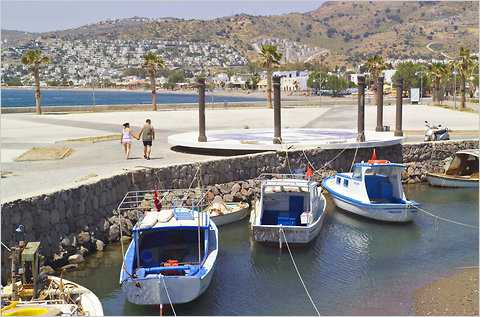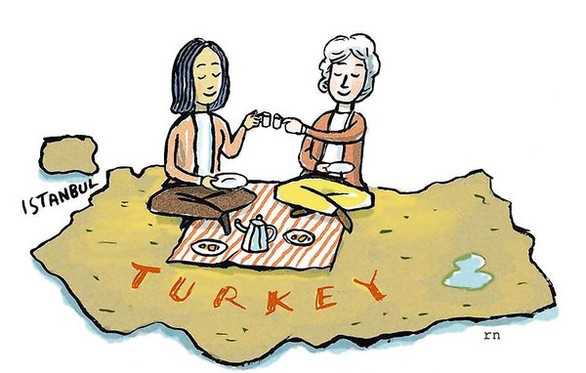By Doug French
The Grand Bazaar in Istanbul has been a beehive of mutually beneficial exchanges for 550 years. Americans may think of Rodeo Drive or Madison Avenue when they think shopping, but while everyone pays the sticker price in America, price tags are rare at the Grand Bazaar.
Show any interest in an item at one of the 4,300 shops in the bazaar and the proprietor or store employee will engage you immediately. If English is your language and he doesn’t speak it, in seconds someone will appear who does. This shopping experience isn’t anything like a leisurely stroll through Walmart, where you only occasionally spot blue-smock- and big-button-wearing employees.
With thousands of choices, shopkeepers try a variety of come-ons to get passing shoppers to look at their wares. Some make you feel foolish: “You look lost, come in my shop.” Others make you laugh: “Let me sell you something you don’t need,” or “Cheaper than Walmart!” And then there’s the appeal to the shopper’s ego: “You look like a professional rug buyer. Come and see my selection.”
American tourists may think they’re good negotiators, but they’re at a distinct disadvantage in the Grand Bazaar. The bargaining can take place in three currencies and skip back and forth.
Not knowing whether a buyer is holding Turkish lire, euros, or US dollars, sellers were initially quoting prices in lire (this was not the case when I was first there in 2006, when they preferred euros). But when I produced my money clip containing euros, the shopkeeper quickly switched. I thought I had shut him down, not finding a shirt offering adequate neck girth, but he told me to hold still and sprinted down one of the bazaar’s 58 covered streets, deftly dodging shoppers. He was back in a flash, producing four shirts, and he peeled one of the packages open so I could try it on and see if the size was right.
It was. There was no going back. The 90-lira quote was now €60. That day a lira only brought €0.44. So the initial offering price had gone up considerably. However, I was thinking in dollars. The shirt he was trying to sell me goes for about $150 in the states. That day, €1 fetched $1.46. Seemed like a smoking deal to me. How could I buy just one? Despite not being an impulse buyer, I walked out with the four shirts for €180.
Feeling satisfied after buying shirts I probably didn’t need, I did require a pair of sunglasses. A shop just down the corridor sold nothing but. My friendly shirt seller followed me there. The sunglasses sellers also first offered prices in lire, but the shirt seller said something to them in Turkish that I didn’t understand. He then looked at me and said, “These guys are friends of mine. I told them to give you a good deal.”
I suspect it may have been just the opposite.
There are hundreds of thousands of negotiations going on under the roof of the 47,000 square meter bazaar each minute up until closing time. The Turkish monetary authorities have a history of debauching their currency so Turks store their wealth in gold and rugs. It’s no surprise there are 373 jewelers and 125 rug stores in the bazaar. Souvenir shops are also prominent (217), as are shops selling leather goods (114).[1]
In 1966, one US dollar bought 9 lire. By 2001, a dollar bought 1.65 million lire. Four years later, six zeros were lopped off the lira and a dollar equaled 1.29 new Turkish lire. Today, a dollar can be traded for around 1.60 lire.
The last half-decade of tamer inflation has helped make the Turkish economy one of the strongest. However, Ahmet Akarli, an economist at Goldman Sachs in London, tells The Economist, “The cyclical picture is looking ugly, imbalances are accumulating and financial vulnerabilities are growing.” Akarli says wages are up 18 percent, domestic demand is increasing 25 percent, and credit growth is 30 to 40 percent.
Buying jewelry and rugs can take hours. Shop owners are friendly and recognize a tired and thirsty spouse immediately, producing a stool and water so that an impatient husband won’t get in the way of trade. While less expensive goods are quickly negotiated, one can spend all afternoon dickering over handmade carpets and jewels.
Hakan Evin is one of these friendly merchants; he has been selling rugs for nearly three decades despite not having turned 40. Profiled in the Hurriyet Daily News, Evin sold his first rug at age 12 and competes against his father and brother, who have another store. He works from 8 a.m. to 7 p.m., six days a week. The bazaar is closed on Sunday. Hillary Clinton buys her rugs from Mr. Evin and sends him plenty of customers. George H.W. Bush, Demi Moore, and Eric Clapton are also customers.
The area near the Grand Bazaar is the heart of the jewelry sector — not just in selling jewelry but making it as well. The master-apprentice relationships known as the Covered Bazaar train thousands of Armenian craftsmen in jewelry manufacture. The work is exacting and painstaking. A calm demeanor and steady hands are required.
The wooden workbenches look to be ancient, with decades’ worth of craftsmen’s initials carved into the benches. A leather sort of basket is attached so as to catch any stray gold flakes or precious stones. I was told there are buyers for the sewer water from the bazaar district, because enough gold finds its way there.
Even on the quietest day, $20 million changes hands between the 250,000 to 400,000 tourists and the 30,000 workers employed in the bazaar. Three of the five daily calls to prayer occur while the bazaar is operating, but no one stops to pray; there is business to be done.
Experts in these matters say stores in the bazaar offer some of the best purses anywhere. A New York Times reviewer of Kiyici Genuine Fake Bags writes,
Just because these are not the originals doesn’t mean they’re of inferior quality or you’re not going to need a full wallet to walk out of here with a little morsel. GFB carries Prada (with bargaining that begins at $250/£125), Louis Vuitton, and other big names.
Sadly, Istanbul police recently raided 137 shops in the Grand Bazaar, looking for what the press called counterfeit goods: “Sacks of counterfeit goods, particularly handbags, watches and scarves, were confiscated,” reports the Hurriyet Daily News.
However, commerce was moving along at full bore when we visited more than a month after this raid. The Grand Bazaar’s construction started in 1455, and it opened in 1461. It was most likely built next to the site of the market used by the Byzantines. Sultan Mehmed the Conqueror ruled Constantinople (now Istanbul) when the bazaar was built. It was vastly enlarged in the 16th century, during the reign of Sultan Suleiman the Magnificent, and in 1894 underwent a major restoration following an earthquake. An earthquake in 1999 also damaged the bazaar. Time marches on while exchange continues.
People trade to make their lives better. And this temple of trade has thrived for centuries. If earthquakes can’t shut the Grand Bazaar down, surely the intellectual-property police can’t stop the mutual satisfaction of wants.
Douglas French is president of the Mises Institute and author of Early Speculative Bubbles & Increases in the Money Supply. He received his masters degree in economics from the University of Nevada, Las Vegas, under Murray Rothbard with Professor Hans-Hermann Hoppe serving on his thesis committee. See his tribute to Murray Rothbard. Send him mail. See Doug French’s article archives.




